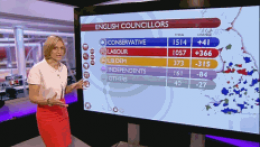Viz Touch Screen for BBC News
Interactive touch screens are becoming an increasingly important tool in the world of broadcast graphics – with election coverage leading the charge. BBC News asked Idonix to apply their specialist knowledge of Viz scene scripting and live data integration to help their in-house team build a touch screen application for the 2011 UK election coverage.
Think we could be a good fit for your next project? Get in touch
Situation
This time around the BBC decided to move their core results graphics away from the traditional full
form approach into a touch screen environment. They had plenty of in-house design and Viz Artist
expertise and 103“ U-Touch screen, but needed help integrating live data and fluid transition
logic into their Viz scene.
Solution
Working closely with the BBC’s editorial and design teams, Idonix’s first task was to build a prototype that would allow the team to quickly trial different ideas for screen layout and navigation. The prototype was developed with Microsoft Sketchflow, a Silverlight based tool that allowed team members to contribute feedback via the web.
The basic Viz scene was then built by the BBC’s in-house Viz developers. When complete it was handed to Idonix for the addition of transition logic and data integration script. In addition scripted control interfaces were added to the IGO automation system to allow live data feeds and producer controlled stacking.

Live Data
As the presenter navigates to a new page Viz sends a corresponding request to IGO – ensuring that the data is always fresh and up to date.

Real-time Updates
Where appropriate – for example with scoreboards – the figures update in real time, keeping results perfectly in sync with other graphics, for example the tally.

Transition Logic
The request/response based architecture allows for centralised transition login within the script controllers, leading to fluid and robust operation.

External Control
The same request/response mechanism means that the graphics can be driven not just from the touch screen itself, but also from the producer’s IGO client, or even from an iPad, Android or Windows tablet.

